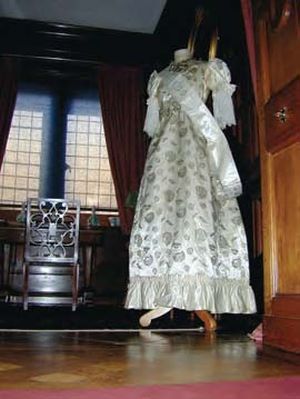|
During the summer I visited an exhibition entitled ‘The Ladies of Lanhydrock’ which was running at Lanhydrock House, near Bodmin, Cornwall until October. I was first alerted to the exhibition by Stella Turk who sent me a newspaper cutting which illustrated a rather unusual dress. Made in silk, it features a design of stylised cockle shells and gastropods. The exhibition and a numbered trail round the house delves into the lives of the important women of Lanhydrock from 1642 to 1969 and focuses on key figures from the children’s nanny to the lady of the house. The histories of these ladies are often colourful and range from grandiose weddings to imprisonments. The exhibition focuses on their achievements as wives, mothers, patrons and entrepreneurs but also their roles as women in their own right. At Lanhydrock they have been vital in the continuity of ownership of the house and estate. As the visitor sees the property today, it is essentially a Victorian home, both in its furnishings and the numerous ornaments, artefacts and household objects displayed in their everyday settings. The Jacobean house and its 400 acre estate were given to the National Trust by the 7th Viscount Clifden in 1953. The house has experienced several phases of building, the most recent being that which took place after a disastrous fire in 1881 which destroyed the south wing and damaged the central range. Fortunately the beautiful Long Gallery with its superb plasterwork ceiling survived. The rebuilding work resulted in an extensive kitchen complex with every Victorian convenience a large family home might require and which consists of the main kitchen and seven associated rooms: the scullery, bakehouse, dry larder, fish larder, meat larder, dairy scullery and dairy. With all the associated equipment in situ, this gives a realistic and fascinating insight into the methods and materials used to keep fresh, process and cook the raw ingredients that fed the household. To return to the dress, it was worn by Mary Vere Agar-Robartes (1879-1946) at the New Year’s Party in 1899 to mark the arrival of the 20th century. Although the design on the dress looks as if it has been embroidered it is actually stamped on. The ink used is slatish grey, has a slightly metallic appearance and reminded me of the effect I used to achieve when doing potato printing in art classes at school. There are paint marks on the inside which suggest that the dress was home-made, possibly by the Governess. The dress is cotton lined but there is no label, as there is in most of the children’s fancy dress costumes. The accompanying sash is dated 1900 to commemorate the new millenium. There is an accompanying novelty jingly necklace of simple metal shells. It may be that the party was fancy dress, with a theme, such as the sea. It does not appear to be documented whether Mary had a particular liking for shells, or indeed if she collected them. But I’d like to think she did. |
|
Cockle Frock graces New Year Party
Issue
12
Page
19

 Cockleshell dress worn by Mary Vere Agar-Robartes at a New Year’s Party in 1899. With kind permission of the National Trust.
Cockleshell dress worn by Mary Vere Agar-Robartes at a New Year’s Party in 1899. With kind permission of the National Trust.